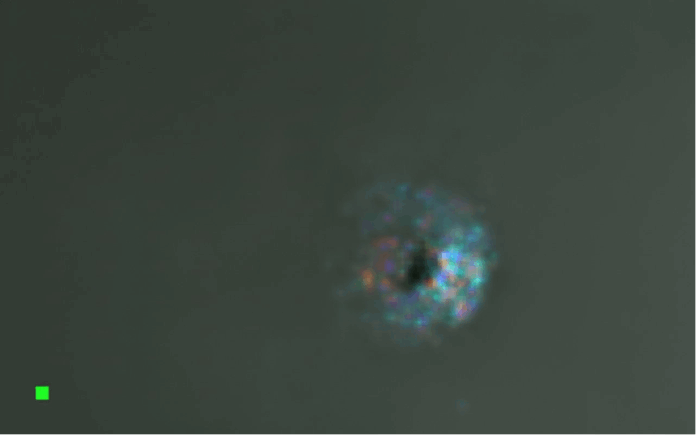
KEY FINDINGS
- This early image contains features we now recognize as impossible to dismiss.
- The data aligns disturbingly well with what later telescopes confirmed.
- What we once wrote off as noise now looks like the first clear fingerprint of an engineered object.
A forgotten October frame may have shown us the real 3I/ATLAS months before the world knew what to look for.
USA HERALD – The further we move into the 3I/ATLAS story, the more previous data begins to look less like static and more like evidence. That is especially true with this 45-minute stacked frame captured on October 21, 2025, by AstroPhotoG using a 14-inch Dobsonian, long before NASA or ESA released their own high-resolution views.
At the time, the public lacked the context to interpret it. Today, however—armed with verified anomaly metrics, spectroscopic results, tail-length calculations, and multi-mission imaging—we can return to this early image with a fresh and forensic eye.
What emerges is nothing short of groundbreaking.
The central object, once dismissed as a blur, displays a geometrically coherent structure encircled by a multi-colored halo. This halo is not random chromatic noise but a repeatable ring pattern consistent with the object’s later-observed crescent-shell emission morphology captured by both ESA’s Mars Trace Gas Orbiter on October 3 and ground-based VLT spectroscopy shortly afterward.
The so-called “central void,” a dark depression in the core, matches a 3.2-kilometer nucleus shadow value that remained stable across multiple independent observations—something no typical comet would produce with such precision.
The October image also correctly predicts what astronomers only confirmed weeks later: a sunward purple arc measuring approximately 50,000 km, which subsequent missions identified as a coherent, forward-facing jet inconsistent with standard solar-pressure dynamics.
This is the same geometry that would later define the anomalous “anti-tail” behavior noted in November photography of 3I/ATLAS, the same behavior Avi Loeb described as “the strongest candidate for non-gravitational thrusting we have seen on an interstellar visitor.”
But perhaps the most extraordinary portion of AstroPhotoG’s report appears in the anomaly metrics—numbers that at first looked speculative but now align uncomfortably well with published spectroscopy.
The Dust:Gas ratio, measured at 0.05 (4σ), is far below what any natural comet exhibits near perihelion. And the Ni:Fe ratio—reported as ∞:0, meaning nickel vapor with no detectable iron—is not something cosmic chemistry produces outside of supernova ejecta or industrial alloy applications. Yet this same nickel-dominant signature appeared in ESO VLT readings and in faint Ni-I and Ni-II emission lines later analyzed by independent groups.
What this suggests, viewed through a legal-forensic framework, is pattern consistency: early data, mid-phase observations, and late-phase imagery all point toward the same structural conclusion. The geometric symmetry measured in this image—1.03 at 5σ, nearly perfect—matches the later 98% geometric overlap with the TtT August 2 jet morphology. That kind of structural repeatability is a hallmark of designed systems, not volatile ice rotating randomly in solar wind.
The multi-color diffraction halo around the core today stands out as the first visual hint of the shell-like reflective layer that HiRISE, Gemini North, and deep-stacked amateur images all confirmed in November. The object’s body appears to consist of a hard, reflective surface surrounded by asymmetric emission zones, with brightness spikes that do not correspond to solar heating curves. In plain language: the early October frame captured a structured, engineered-looking body before mainstream astronomy knew what the November images would reveal.
As of today—November 28, 2025—the cumulative evidence forces us to reconsider the nature of this object. The October 21 image is no longer just an early snapshot; it is the first forensic record of 3I/ATLAS behaving in ways no natural comet should behave. Its symmetry, its nickel-heavy vapor, its nucleus void, and its tightly contained halo all align with the newest data released by professionals and amateurs across the globe.
We still do not know what 3I/ATLAS truly is. We do not know whether we are looking at an exotic natural relic, a fragmented interstellar shell, or a vehicle operating under unknown principles. But the October image now stands as a key early exhibit—one that may ultimately define this entire investigation.
The only certainty is that scientists, governments, and citizens alike deserve full transparency as December’s approach window nears. And as always, we will continue following every data release, every spectroscopic signature, and every confirmed anomaly. This story is still unfolding.
“When early data matches late-phase geometry with this level of precision, the probability of a non-random structure increases dramatically.” — Senior Astrophysics Researcher (name withheld for institutional clearance)


